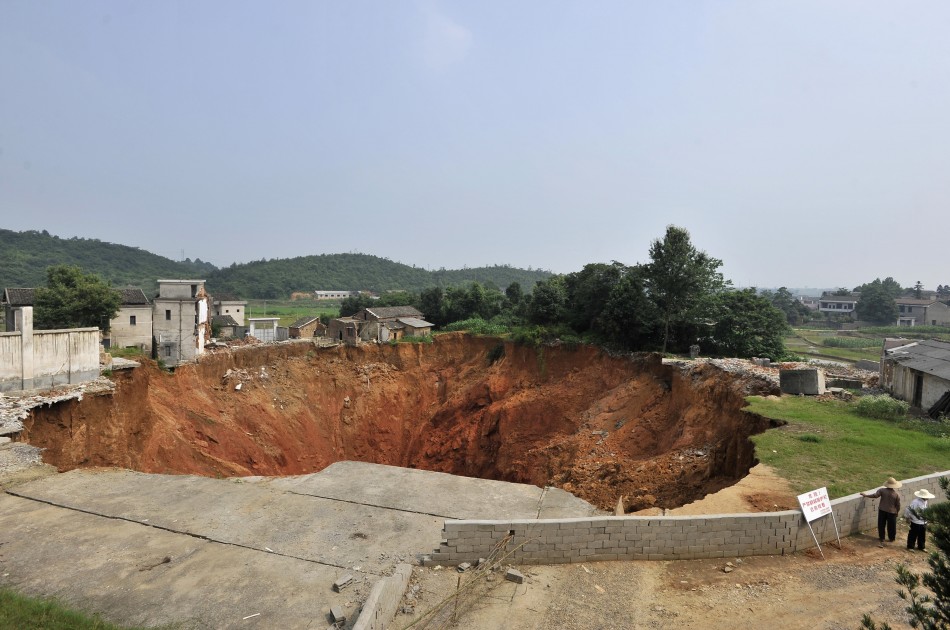China Sinkholes: Poor Development Plans Blamed for Mounting Collapses [PHOTOS]
Sinkholes have been appearing with increasing regularity in China in recent years, sparking concerns about the safety standards adopted by the country's urban developers.
In 2007, "only" 54 sinkhole collapses were reported. The number of incidents increased to 94 in 2008 and went up to 129 in 2009.
According to statistics from a bridge maintenance company, in the space of just 22 days in July and August last year, 99 sinkholes opened across the capital Beijing.
In June last year, a sinkhole swallowed a minibus in the city of Guilin, in the neighbouring Guangxi province, injuring the driver.
A few days later 355 people were evacuated in the Tanluo village of Nanning City, about 300km northeast of Guilin, after five holes opened up in the area.
Guangxi is in a traditional karst region, where natural depressions caused by groundwater recession and erosion are not uncommon.
However one year earlier, China's premier Li Keqiang had warned against "overzealous exploration of underground water supplies" which might cause geological disasters such as sinkholes, Xinhua reported.
"A sinkhole in a geological context is a surface depression caused by the subsidence of the ground due to dissolution of a soluble rock [usually limestone, chalk salt or gypsum - ie 'karst' areas] at depth," Dr Andrew Farrant a geologist and karst geomorphologist at British Geological Survey explained to IBTimes UK.
"China has a massive amount of limestone, especially in the southwest of the county, and many of its urban areas, for example Guilin are situated on limestone areas," Farrant said.
Other incidents have sparked concerns about construction safety standards in the country.
A video showing a man sliding to his death in a sinkhole in the city of Shenzhen, a few kilometres north of Hong Kong, has been posted online this week.
Shenzhen is in the Guangdong Province, where another sinkhole measuring 300 sq m in width (3229 sq ft) swallowed several buildings in January.
Five shops slid into the crater in the province capital of Guangzhou. No one was injured but power was cut to about 3,000 residential units.
Shenzhen authorities have blamed heavy rains and aging water pipes running beneath the surface. However both the Guangdong incidents happened near a construction work site.
A building for Media company Shenzhen Press Group was being built just two metres away from the sinkhole in Shenzhen, while an underground rail tunnel was being worked on in Guangzhou.
Wang Mengshu, a member of the Chinese Academy of Engineering, said that faulty underground infrastructure projects are a major cause of many sinkhole collapses, Caixin reported.
"Karstic sinkholes, whilst a natural phenomena are often induced or accelerated by human activities. Many cavities are generally stable until some event triggers their collapse. Natural events such as heavy rain, flooding, drought and earthquakes can trigger sinkholes, but humans are often a contributory factor," Farrant added.
"Groundwater abstraction, burst water mains and leaking sewers, poorly designed or maintained soakways, inappropriate drainage, and poor building design/inadequate site investigation are all documented causes of sinkhole collapse.
"If inappropriate care has been taken during the ground investigation, design and construction phase, or if the geology of the area has not been adequately investigated, then the likelihood of sinkhole collapse in susceptible areas increases.
"Similarly, poor design, construction and/or maintenance of infrastructure (such as leaking pipes) often triggers sinkhole collapse."






© Copyright IBTimes 2025. All rights reserved.






















